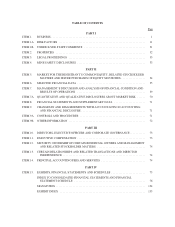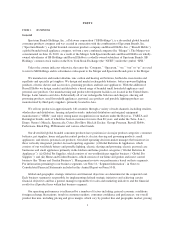Rayovac 2012 Annual Report Download - page 17
Download and view the complete annual report
Please find page 17 of the 2012 Rayovac annual report below. You can navigate through the pages in the report by either clicking on the pages listed below, or by using the keyword search tool below to find specific information within the annual report.Under the agreement as extended, Russell Hobbs agreed to pay BDC royalties based on a percentage of sales,
with minimum annual royalty payments of $15.0 million from calendar year 2011 through calendar year 2015.
The agreement also requires us to comply with maximum annual return rates for products.
If BDC does not agree to renew the license agreement, we have 18 months to transition out of the brand
name. No minimum royalty payments will be due during such transition period. BDC has agreed not to compete
in the four core product categories for a period of five years after the termination of the license agreement. Upon
request, BDC may elect to extend the license to use the Black & Decker brand to certain additional product
categories. BDC has approved several extensions of the license to additional categories and geographies.
Competition
In our retail markets, we compete for limited shelf space and consumer acceptance. Factors influencing
product sales include brand name recognition, perceived quality, price, performance, product packaging, design
innovation, and consumer confidence and preferences as well as creative marketing, promotion and distribution
strategies.
The battery product category is highly competitive. Most consumer batteries manufactured throughout the
world are sold by one of four global companies: Spectrum Brands (manufacturer/seller of Rayovac and VARTA
brands); Energizer Holdings, Inc. (“Energizer”) (manufacturer/seller of the Energizer brand); The Procter &
Gamble Company (“Procter & Gamble”) (manufacturer/seller of the Duracell brand); and Matsushita
(manufacturer/seller of the Panasonic brand). We also face competition from the private label brands of major
retailers, particularly in Europe. The offering of private-label batteries by retailers may create pricing pressure in
the consumer battery market. Typically, private-label brands are not supported by advertising or promotion, and
retailers sell these private label offerings at prices below competing name-brands. The main barriers to entry for
new competitors are investment in technology research, cost of building manufacturing capacity and the expense
of building retail distribution channels and consumer brands.
In the U.S. alkaline battery category, the Rayovac brand is positioned as a value brand, which is typically
defined as a product that offers comparable performance at a lower price. In Europe, the VARTA brand is
competitively priced with other premium brands. In Latin America, where zinc carbon batteries outsell alkaline
batteries, the Rayovac brand is competitively priced. Our primary competitors in the portable lighting product
category are Energizer and Mag Instrument, Inc.
The pet supply product category is highly fragmented with over 500 manufacturers in the U.S. alone,
consisting primarily of small companies with limited product lines. Our largest competitors in this product
category are Mars Corporation (“Mars”), The Hartz Mountain Corporation (“Hartz”) and Central Garden & Pet
Company (“Central Garden & Pet”). Both Hartz and Central Garden & Pet sell a comprehensive line of pet
supplies and compete with a majority of the products we offer. Mars sells primarily aquatics products.
Products we sell in the home and garden product category through the Home and Garden Business face
competition from The Scotts Miracle-Gro Company (“Scotts Company”), which markets home and garden
products under the Scotts, Ortho, Roundup and Miracle-Gro brand names; Central Garden & Pet, which markets
garden products under the AMDRO and Sevin brand names; and Bayer A.G., which markets home and garden
products under the Bayer Advanced brand name.
Products we sell in the household insect control product category through the Home and Garden Business
face competition from S.C. Johnson & Son, Inc. (“S.C. Johnson”), which markets insecticide and repellent
products under the Raid and OFF! brands; Scotts Company, which markets household insect control products
under the Ortho brand; and Henkel KGaA, which markets insect control products under the Combat brand.
Our primary competitors in the electric shaving and grooming product category are Norelco, a division of
Koninklijke Philips Electronics NV (“Philips”), which sells and markets rotary shavers, and Braun, a division of
7
























